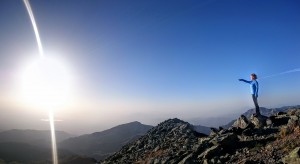The World’s Best New Mega-Trekking Route Uses Cooperation to Connect the Western Balkans from Slovenia to Macedonia
 The Via Dinarica “mega” hiking trail stretches nearly 2,000 kilometers and traverses the Western Balkans through the mountains of Slovenia, Croatia, Bosnia and Herzegovina, Montenegro, Albania, Kosovo, Serbia, and Macedonia. And though travel publications have called the route the world’s best new long-distance trekking path, the trail itself represents only a small part of the journey’s importance.
The Via Dinarica “mega” hiking trail stretches nearly 2,000 kilometers and traverses the Western Balkans through the mountains of Slovenia, Croatia, Bosnia and Herzegovina, Montenegro, Albania, Kosovo, Serbia, and Macedonia. And though travel publications have called the route the world’s best new long-distance trekking path, the trail itself represents only a small part of the journey’s importance.
The Via Dinarica is both a cultural corridor and a historic, collaborative initiative among Balkan adventure tourism companies determined to shine an overdue light on this beautiful, misunderstood, and underappreciated corner of southeastern Europe.
Starting in the north, the Via Dinarica hugs peaks above the Adriatic Sea and then heads east and south across the Dinaric Alps and the adjacent Sharr Mountain Range. The path connects ancient trading routes and shepherds’ mountain transversals and can be enjoyed as a thru-hike or as a series of day-hikes. Along the way, this cultural corridor links some of Europe’s last remaining old-world traditions. The route provides a lens through which travelers can discover the region’s unique gastronomy, preserved landscapes, heritage, and adventure. The trek crosses over mountain summits—the tallest being Mount Korab between Albania and Macedonia at 2,764 meters—and acts as a synapse between valleys, towns, and villages. Adventurers sleep in boutique B&Bs, manned mountain huts, unmanned shelters, tents, and under temporary lean-tos in nomadic shepherd communities.
The genesis of the Via Dinarica dates to 2009. In 2010, a pilot portion of the trail connected Sutjeska National Park in Bosnia and Herzegovina and Durmitor National Park in Montenegro. In 2013, the route was charted from Slovenia to the border of Kosovo, Albania, and Montenegro. The trail was then extended to the Sharr Mountains, which straddle Kosovo, Macedonia, and Albania. In 2014, American adventure magazine Outside named the Via Dinarica the world’s best new hiking trail. In 2015, Paste magazine did the same. Wanderlust travel magazine and The Guardian shortlisted the trail as a must-do adventure stop for 2016.
During the trail’s growth, four of the Western Balkans’ best adventure-tourism companies decided to collaborate to promote the trail as a cross-border vehicle for discovery and to create one-of-a-kind itineraries for adventure and culture seekers. The result is the Via Dinarica Alliance. These adventure companies—from Albania, Bosnia and Herzegovina, Croatia, and Montenegro—openly share their local expertise with one another and are presently co-leading tours to give adventurers the best possible experience across the trail. The members of this forward-thinking cooperative are committed to showing off the region, changing a misconceived narrative, and partnering with other like-minded international tourism companies.
“We are much stronger when we work together,” said Alliance member Thierry Joubert, who was recently in London for the Adventure Travel Show. At the show, the Alliance joined forces and shared a stand with another collaboration: the Western Balkans Geotourism Network. “But most importantly,” Joubert continued, “travelers are the ones who benefit most when we streamline the information needed to visit and work in a positive, helpful, and cooperative spirit.”
The Alliance is the very essence of sustainability because it connects companies that have already achieved success and yet still see the value of cooperation to guarantee continued responsible growth across the region. By coming together with a sense of camaraderie, countries are putting aside differences to work in harmony across unspoiled, rugged landscapes and ancient culture. The membership network caters to tourists who potentially like to be active—but, importantly, those looking for an easy-to-understand vehicle to enjoy an area that has become the new star of European tourism.
